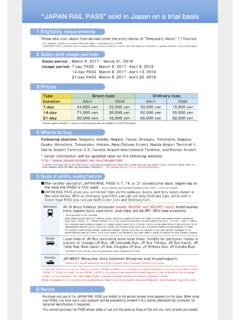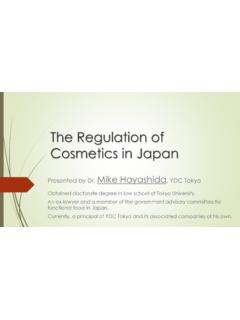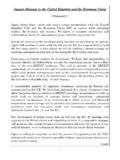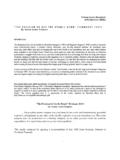Transcription of DRIVING IN JAPAN AND PASSING THE DRIVER’S …
1 DRIVING IN JAPAN . AND. PASSING THE DRIVER'S TEST. by: Melissa Fedak Hiroshima-ken ALT 2003-2005. This book can also be found online at: DRIVING in JAPAN and PASSING the Driver's Test CHAPTER 1. The Price of Freedom: Buying and Owning a Car in JAPAN CHAPTER 2. The Written and Unwritten Rules of the Road CHAPTER 3. So You've Been Here A Year: Getting a Driver's License in JAPAN CHAPTER 4. The Written Test CHAPTER 5. The Practical Test CHAPTER 6. DRIVING School APPENDIX A. Helpful Japanese Terms APPENDIX B. Additional Websites and Information APPENDIX C. Sample DRIVING Courses APPENDIX D. List of Prefectural DRIVING Centers Author's Apology: The spellings and words in this book are American English. I. use license instead of licence, windshield instead of windscreen, curb instead of kerb, and so forth. I'm not trying to mess with your head, I'm just using an American spellchecker. CHAPTER 1. THE PRICE OF FREEDOM: BUYING AND OWNING A CAR IN JAPAN .
2 Contents: 1. Am I Allowed to Own and Drive a Car in JAPAN ? 2. What Should I Buy? 3. What are the Costs of Buying? 4. What are the Costs of Owning? AM I ALLOWED TO OWN AND DRIVE A CAR IN JAPAN ? Can I drive a vehicle in JAPAN ? Yes, you are allowed to drive a vehicle in JAPAN if you have either a Japanese driver's license or an International Driver's Permit IN. CONJUNCTION WITH a valid driver's license from your home country. Using the permit, you can drive in JAPAN for up to one year after your first date of arrival. You cannot drive on your home country license alone not even for a rental car! - unless you are from Germany, France, or Switzerland, in which case you must also carry an official Japanese translation of your license. You must have a motorcycle license in your home country to drive a motorcycle. Where do I get an International Driver's Permit? It is easiest to get one before you leave at a local Automotive Association, but if you are already here, you can often get one through the mail.
3 You can only get International Driver's Permits from your home country. Be cautious of internet scams and use a proper authority. (See for a list of recognized authorities, usually major automotive associations.) Under new law, your International DRIVING Permit is only valid for a maximum of one year and cannot be renewed unless you have been in your home country for at least three months straight. Can I own a vehicle in JAPAN ? Yes, you are allowed to own a vehicle in JAPAN . Your contracting organization cannot keep you from buying or using a car if you so desire, even to drive to work. They can restrict you from using it to drive between places of work, however. Some contracting organizations will give you or help you buy a car, some will try to discourage it. 1. WHAT SHOULD I BUY? There are variety of vehicles available to drive in JAPAN . Cars of all sizes, motorcycles, and scooters, each with different license rules, traffic rules and costs share the road.
4 Deciding what to buy depends on your needs. If you only need to get around town occasionally, you may want a smaller car or scooter. If you want to take friends and explore JAPAN 's roads, a larger, more powerful car will suit you better. For regular commuters, it may come down to a simple preference. Scooters If you decide to drive a 50cc or less scooter (good for low-speed around-town DRIVING in decent weather), the buying process is somewhat easier (and much of the paperwork may be taken care of by the scooter shop.) As for licensing, you can get a separate scooter license which is unrelated to a regular driver's license. To get one, you are only required to take a paper test and a lesson; no practical test. Please see the section on The Written Exam for more details. Motorcycles Note that for any motorcycle, you can only drive it in JAPAN with your International Driver's Permit IF it is specified on it that you are allowed to on your home license.
5 A plain car license is not sufficient. There are two types of motorcycle licenses: Normal, for motorcycles over 50cc up to 400 cc, and Large, for motorcycles 401 cc and over. For exhaustive information on owning and DRIVING scooters and motorbikes in JAPAN , read the JAPAN Biker FAQ at Cars As for cars, there are two main types: White-plate cars: These cars, recognizable by their white-colored license plate, are what typical cars look like in most countries. White-plates are generally more spacious, safer, and have more power that Yellow-plates. They are more expensive to buy and upkeep. A car does not have to be particularly large to be a white plate, but it is always wider than a yellow-plate. Yellow-plate cars: These are narrow, around-town cars. There is not a lot of leg room or trunk (boot) space. They barely make top speeds on an expressway and are not as safe. They are, however, a lot cheaper to own and run. Buying You have two choices when purchasing a car.
6 Either purchase from a dealer (new or used cars) or from another person. The benefit to purchasing from a dealer is that the dealer will do a large amount of the paperwork. Also, there is some assurance of quality. The benefit to purchasing from another person is that the price is likely to be a lot cheaper. If you want to buy from another person, but do not want to do the paperwork, you can hire a dealer or pay someone at the Land Transport Office to do it for you. 2. The two basic things you have to do when you a buy a car are: Register the vehicle and transfer ownership Verify a parking space These two steps involve a great deal of paperwork and complicated Japanese forms. Taking a Japanese-speaker with you is practically a necessity if you cannot read or speak Japanese. If you do not use a dealer, you will need the below (you may not need everything for a Yellow-Plate, but you will need most of it): Documents you need to buy a car: 1.
7 Alien Registration Card (gaikokujin torokushomeisho) or Alien Registration Completion Certificate if your card has not been issued yet. 2. Personal Seal (inkan or hanko). 3. Personal Seal Certificate (inkan shomeisho) from your local public office. 4. Parking Space Certificate (shako shomeisho) from the police station in the municipality where you applied for alien registration. (This may not be needed in a rural area. See below on how to get one.). 5. Valid Driver's License (unten menkyo). Documents you need to transfer a car: All of the above as well as: 1. Deed of Transfer (joto shomeisho). 2. Personal Seal Certificate (inkan shomeisho) of the previous owner 3. Alien Registration Card (or juminhyo if they are Japanese) of the previous owner. 4. Letter of Attorney (inin-jyo) stamped by previous owner if possible 5. Compulsory Insurance Certificate (jibaiseki hoken-sho) from the previous owner (or, if you are getting it for the first time, you can only do so once the shaken is in your name, so do shaken first.)
8 6. Shaken Inspection Certificate (shaken-sho) from the previous owner 7. Proof of Payment of Automobile Tax (jidoushazei noufu shoumeisho). from previous owner (may not be needed). How do I get proof of a parking space? Find the person who is renting (or willing to rent) you a parking space within 2km of where you live, often the landlord, building owner, real estate agent, building management company of the building you live in, and ask for an official document showing that the space is yours. This document is a Certificate of Permission for Use of Parking (hokan basho shodaku shomei) and it must be stamped by the agent. Then go to the local police station and fill out an application form as well as an application form for a badge (hyosho) so you can certify the space. You have to draw two maps in a detailed manner: one of the area (including nearby landmarks). and one of the parking space, including the space number if there is one, the dimensions (in meters) of the spot and the width of any adjacent roads.
9 This takes about a week to process. Note that small / light cars may not need this certificate in less urban areas. Bring all necessary documents to the local Land Transport Office (ikuun jimusho). If it is a different Office than the car was previously registered in, then you will have 3. to get new license plates as well. If possible, go together with the previous owner, bringing all relevant items. Note that the officials will be very, very particular about details. If you fill out a form wrong, you will have to do it over or come in another day. ** Note that the Personal Seal Certificate is only valid for 3 months! If it has been longer than that, for either the buyer or the seller, you need a new certificate (which may be difficult if the seller has left the country.) **. If you purchase through a dealer, you generally need only your Personal Seal Certificate and the Certificate of Permission for Use of Parking.
10 They will take care of the rest. The entire process may take up to 10 days for a White Plate (but may be done in a day if a Yellow Plate.). WHAT ARE THE COSTS OF BUYING? Used cars are worthless without shaken. Period. If the car you are buying has less than a year of shaken, it should be virtually free, unless it is fairly new and in very good condition. The same logic applies when you are selling. If you have no shaken left and do not get more, you might not be able to sell your car (or even give it away) and you will have to pay a scrap dealer to take it off your hands which can cost 10,000 to 20,000. The prices below are what you can expect to pay for a car with full shaken (valid for 2 years; 3 years if brand new). White Plate Yellow Plate Cost of a Car (used) 240,000 300,000 160,000 . 220,000. Cost of a Car (new) 1,000,000 and up under 1,000,000. Automobile Acquisition Tax 5% of the price of the car Automobile Tonnage Tax 50,000 75,000 under 50,000.





